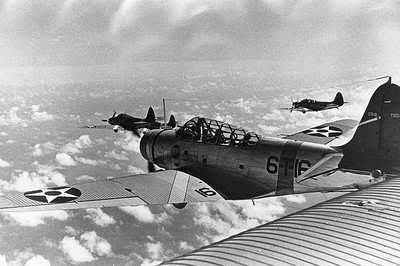TBD's Submerged Since WWII In South Pacific
Divers and other crew members from USS Safeguard assisted the
Naval Historical Center (NHC) and The International Group for
Historic Aircraft Recovery (TIGHAR) in a scientific survey of two
submerged World War II aircraft in waters near Jaluit Atoll,
Republic of Marshall Islands on October 12.

The submerged aircraft — lost since the early days of
World War II — are two U.S. Douglas Torpedo Bomber
Devastators (TBDs). The teams collected samples from the wrecks to
determine their suitability for recovery and preservation.
"This was a unique opportunity for Safeguard to be involved in
the conservation and preservation of an important part of naval
history," said Lieutenant Commander Doyle Hodges, Safeguard’s
commanding officer. "Just the process of getting to the wreck site
in the Marshalls gives you a good appreciation for the bravery of
the Sailors who took these aircraft with rudimentary navigation
systems across thousands of miles of open ocean. Additionally, the
diving conditions in the lagoon were terrific."
These planes were lost after attacking the Japanese headquarters
on the Marshall Islands immediately following the bombings of Pear
Harbor. They launched from USS Yorktown, but couldn't find a path
through the weather back to the ship. They ran out of fuel, and
ditched in the large central lagoon near the Jaluit Atoll.
TBDs served with distinction at the Battle of Midway. At Midway,
the "Devastators" suffered horrendous losses, but by diverting the
Japanese fighter cover, they enabled the American dive bombers to
do their deadly work in destroying Japanese carriers. That victory
would turn the tide of the Pacific War.
One of the two TBD Devastators rests on a coral ledge at only 50
feet and the other on the bottom at 130. The shallower airplane was
found and identified in 1997. The deeper Devastator was located in
2002.

In 2004, TIGHAR, a civilian nonprofit historical foundation,
conducted an initial survey of the possibility of recovery and
preservation for the National Museum of Naval Aviation.
Dr. Robert Neyland, NHC underwater archaeologist, accompanied
the TIGHAR expedition. Neyland recommended that Navy salvage
experts provide support to plan the logistics of recovery and
transport; Safeguard was chosen for the role.
During the recent survey operation, the TIGHAR team, at their
own expense, mapped the extent of corrosion to both wrecks and
conducted analysis of water chemistry, aluminum thickness
measurements and site mapping. The data collected will tell if
recovery and preservation is feasible.
"Safeguard divers were proud to be a part of a survey effort
that shows promise of leading to a successful recovery of a TBD
Devastator," said Senior Chief Navy Diver Jeffrey Sampson,
Safeguard’s master diver. "The data recovered while working
with TIGHAR and the Naval Historical Society will be an integral
part in future salvage and preservation operations."
ANN salutes the men and women of the USS Safeguard and Task
Force 76.
 ANN's Daily Aero-Linx (05.02.24)
ANN's Daily Aero-Linx (05.02.24) ANN's Daily Aero-Term (05.02.24): Touchdown Zone Lighting
ANN's Daily Aero-Term (05.02.24): Touchdown Zone Lighting Aero-News: Quote of the Day (05.02.24)
Aero-News: Quote of the Day (05.02.24) ANN FAQ: Contributing To Aero-TV
ANN FAQ: Contributing To Aero-TV NTSB Final Report: Cirrus Design Corp SR20
NTSB Final Report: Cirrus Design Corp SR20




